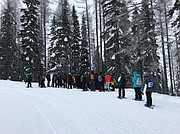Our Gem: Confluence Project Students Dig into Snow Science
Strapped to snowshoes on the slopes of Lookout Pass, students from Lake City High School found themselves reflecting on Coeur d’Alene Lake.
“It was during our descent,” said Elizabeth Edmonds. “I was suddenly struck by the connection of it all. The snow we had just dug up would one day melt and run into our lake.”
Edmonds and her peers from Jamie Esler’s environmental science class are among the thousands of students who have drawn these parallels while participating in the Confluence Project.
The experiential learning program helps high school students understand science in their watershed. It’s a partnership between University of Idaho, the Coeur d’Alene Tribe, Kootenai Environmental Alliance, Idaho Department of Environmental Quality and Panhandle Health District.
The program provides all curriculum, equipment, and field trip funds for schools to participate. Current funders include Alliance Data, Avista Foundation, Coeur d’Alene Tribe Education Department and the Kootenai County Aquifer Protection District.
“[The Confluence Project] challenges my students to work together to solve problems, research real science careers, and engage in the civic responsibility of communicating, collaborating, and volunteering with local organizations,” said Esler. “Most importantly, my students experience and build a relationship with the local mountains, rivers and lakes while on these field trips.”
Throughout the school year, students visit lakes and rivers to measure water quality, tap wells to learn about the aquifer, and snowshoe to quantify snowpack.
“I love getting students outside and teaching them about our watershed on a personal level,” said Marie Schmidt, University of Idaho Coeur d’Alene outreach specialist. “Every year, the Confluence Project provides hundreds of students the opportunity to explore our water resources from snowpack to aquifer and everything in between.”
On this particular day, 50 Lake City High students found themselves digging pits in the snow to determine water availability for the coming year.
“One of the many things I learned at Lookout was how drastically the falling of snow and the steady thaw fuels the entire Inland Northwest and our entire ecosystem,” said Palmer Rakes.
Every snowfall creates a distinct layer in the snowpack, each with different densities and water content. Light, Students measure the density of each layer and calculate the snow water equivalent. They can then compare their findings to data collected by the automated Snow Telemetry (SNOTEL) site at Lookout Pass. SNOTEL sites are located all over the western U.S. and monitored by the Natural Resource Conservation Service. This year, the snow water equivalent in the greater Coeur d’Alene Lake/Spokane River watershed is at 98% of average. At the Lookout site, snow water equivalent is at 94%.
“If you enjoy Coeur d’Alene Lake and the surrounding area, then it is important to know one thing: none of it would be here if it were not for the snow in the mountains,” said student Peter Bukowski. “80% of the water in Coeur d’Alene comes from the snow in the mountains, so it is important to protect our winters.”
The Confluence Project culminates in the Youth Water Summit every spring. Students present water-related research projects at the scientific conference. In an average year, about 10 schools and 500 students participate.
For more student reflections, visit www.uidaho.edu/OurGem. A very special thank you to Lookout Pass for allowing hundreds of students to snowshoe the mountain each year.
For more data on Idaho’s snowpack, visit www.nrcs.usda.gov/wps/portal/nrcs/detail/id/snow/products/?cid=nrcseprd1491224.
The Our Gem Coeur d’Alene Lake Collaborative is a team of committed and passionate professionals working to preserve lake health and protect water quality by promoting community awareness of local water resources through education, outreach and stewardship. Our Gem includes local experts from the University of Idaho Community Water Resource Center, Coeur d’Alene Tribe Lake Management Department, Idaho Department of Environmental Quality, Kootenai Environmental Alliance, Kootenai County, Coeur d’Alene Regional Chamber and CDA 2030.











